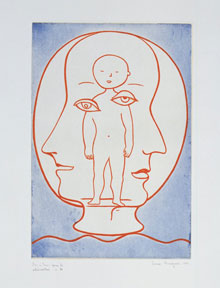
This chronology relates to Louise Bourgeois’s prints and illustrated books, citing and illustrating individual works that serve as touchstones in these mediums across her career, and noting when various printers and publishers began their collaborations with her. It also documents those exhibitions devoted to her printmaking that included publications. (Citations for those publications are found on the Bibliography page of this website.) In order to provide context, significant developments in her sculpture are noted, with representative examples illustrated, as are important events in her personal life and career.
All prints are from the collection of The Museum of Modern Art. If sculptures are in public collections, or in The Easton Foundation (Bourgeois' foundation), that is noted.
1910
1911
Born in Paris on December 25; the middle child, Bourgeois has an older sister, Henriette, and will have a younger brother, Pierre.
1912-19
Family resides in Choisy-le-Roi, outside Paris, with their tapestry restoration workshop behind the house. In 1919 they move to Antony, setting up the workshop there. They also maintain a tapestry gallery in Paris.
1920
1922
Family employs an English tutor, Sadie Gordon Richmond, who lives with the family periodically until 1932.
1923
Begins to assist in family tapestry workshop by drawing missing elements on the tapestries to be restored.
1930
1932
Mother dies after many years of illness; Bourgeois had tended to her and accompanied her on trips to more healthful climates.
1938-39
Establishes an area within her father’s tapestry gallery to sell prints and paintings.
Meets Robert Goldwater, an American art historian, at the gallery. The couple marries and moves to New York; they raise three sons.
Makes first print, St. Germain, a holiday greeting card, in offset lithography; other printed holiday greeting cards follow in the 1940s. In late decades of her life, creates prints as holiday gifts for a small circle of friends.
Enrolls in the Art Students League in 1939, studying painting with Vaclav Vytlacil and lithography with Will Barnet; works on lithographs there into the early 1940s.
1932-38
Studies mathematics at the Sorbonne. Later turns to art, frequenting various Paris ateliers; also studies art history at the École du Louvre.
1938
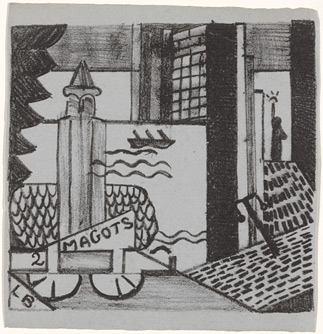
1940
1940s
Early focus is on painting, drawing, and printmaking. Often works on prints at home, eventually purchasing a small intaglio press. Exhibits in various print exhibitions at such venues as the Brooklyn Museum, The Library of Congress, and the Pennsylvania Academy of the Fine Arts.
1946
Begins to work at Atelier 17, the print workshop founded by Stanley William Hayter and relocated from Paris to New York during the war; will work there intermittently until 1949, enjoying the company of an array of international artists.
1947

1949
Shows totem-like wood sculptures in a solo exhibition at the Peridot Gallery; has a second solo show of sculpture there in 1950, and a solo show of drawings and sculpture in 1953.
1941
Family moves to East 18th Street, where they live until 1958; also purchases country home in Easton, Connecticut.
1945
First solo painting exhibition at Bertha Schaefer Gallery, New York; also shows paintings in a solo exhibition at the Norlyst Gallery, New York, in 1947.
1947
Publishes He Disappeared into Complete Silence, an illustrated book comprised of nine engravings and accompanying parables written by the artist; most images are architectural or totemic in nature and resemble wood sculptures she will soon exhibit. Other prints of this time similarly reflect her growing preoccupation with sculpture.
1948
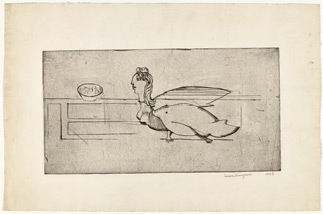
1950
1950
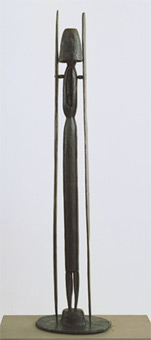
1951
Father dies.
1957
Becomes an American citizen.
1951

1952
Begins psychoanalysis; continues intensively until 1966, and then occasionally until 1984.
1958–59
Making use of the collection of illustrated books and prints she had accumulated over the years, opens a shop called Erasmus Books and Prints, on 11th Street, later moving it to Madison Avenue at 73rd Street. The shop closes in 1959.
1960
1962
Family moves to 347 West 20th Street; Bourgeois lives there for the rest of her life.
1964
Shows new, organically shaped plaster sculptures in a solo exhibition at the Stable Gallery, New York; work differs dramatically from the wood, totemic-like sculptures she exhibited in the late 1940s and early 1950s.
1966
The exhibition Eccentric Abstraction, organized by Lucy R. Lippard, opens at Fischbach Gallery, New York; includes Bourgeois’s work, along with that of Eva Hesse, Bruce Nauman, and others who are seen to define a new, “anti-form” sensibility in art.
1969
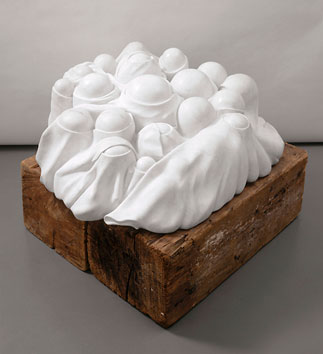
1963
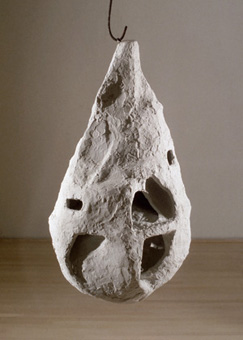
1968

1970
1973
Husband dies.
Participates in a protest march in support of an employee strike at The Museum of Modern Art; carries a banner she has painted with the word “No” repeatedly; makes a related collage and will translate that imagery into various print mediums.
1974
Begins teaching sculpture and printmaking at School of Visual Arts, New York; continues through 1977.
Exhibits the room-sized installation piece The Destruction of the Father in Louise Bourgeois: Sculpture 1970–1974 at 112 Green Street Gallery, New York.
1975
Demonstrating that her work is receiving increasing attention, a major cover article appears in the March issue of Artforum magazine by Lucy R. Lippard entitled, “Louise Bourgeois: From the Inside Out.”
1977
Receives an Honorary Doctor of Fine Arts degree from Yale University; President Gerald Ford is also a recipient.
1978
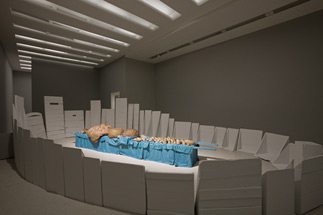
1973

1974

1978–80
Stages elaborate performance with costumed participants called A Banquet/A Fashion Show of Body Parts at Hamilton Gallery, New York; takes place within a room-size sculpture entitled Confrontation.
In response to her disappointment at being excluded from an exhibition at the Whitney Museum of American Art, creates series of rubbings called Whitney Murders.
Meets Jerry Gorovoy through his work at the Max Hutchinson Gallery, New York; he organizes an exhibition of her work there and later becomes her primary assistant.
1978
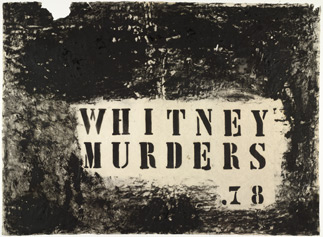
1980
1980
Purchases large loft in Brooklyn for use as a studio, enabling her to create large-scale sculpture; also continues to work at home on West 20th Street.
1983
Is named Officier de L’Ordre des Arts et des Lettres, by Jack Lang, French Minister of Culture.
1984
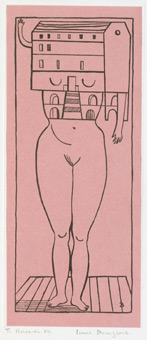
1986
Creates Articulated Lair, a room-size sculpture considered a precursor to her works known as Cells, which proliferate in the 1990s and 2000s.
1988
Meets publisher Benjamin Shiff of Osiris, and Peter Blum of Peter Blum Edition; relationships will lead to extensive range of print projects.
1989
First European retrospective, organized by Peter Weiermair, opens at Frankfurter Kunstverein, West Germany.
Begins working with lithography printer Judith Solodkin of SOLO Impression, intaglio printers Harlan & Weaver, and intaglio printer Christian Guérin of Gravure; will create a variety of projects with Solodkin, and an extensive body of work with Harlan & Weaver, as Felix Harlan eventually establishes a regular routine with the artist involving both his workshop and the small presses set up in her basement.
1982
First retrospective exhibition, Louise Bourgeois, organized by Deborah Wye, opens at The Museum of Modern Art; accompanying catalogue is first monographic study of the artist.
1983
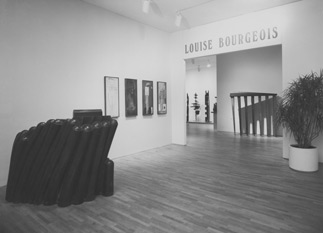
1984
Creates small edition of Femme Maison prints based on a 1947 drawing and related painting; drawing became known as a symbol of the women’s movement in art and served as the cover image of Lucy R. Lippard’s 1976 book, From the Center: Feminist Essays on Women’s Art.
1985
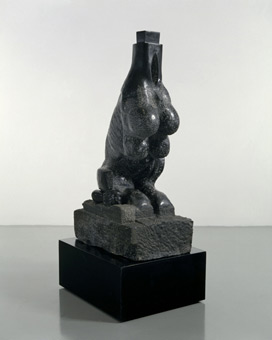
1990
1990
Peter Blum Edition publishes Anatomy, a portfolio of 11 intaglio prints and 1 multiple; imagery reflects her long-standing preoccupation with body parts as subjects.
Osiris (Benjamin Shiff, Director) publishes the puritan, an illustrated book with eight engravings and a text written by the artist in 1947.
1990
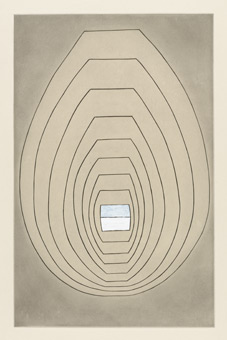
1992
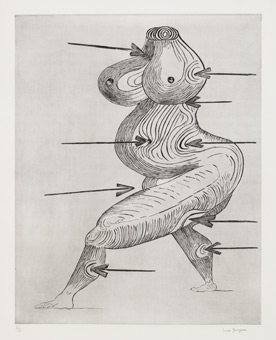
1992

1993
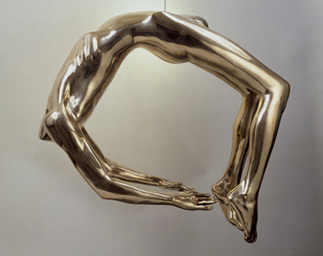
1994
First print retrospective, The Prints of Louise Bourgeois, organized by Deborah Wye, opens at The Museum of Modern Art on the occasion of the publication of a print catalogue raisonné of the same title by Wye and Carol Smith.
1994

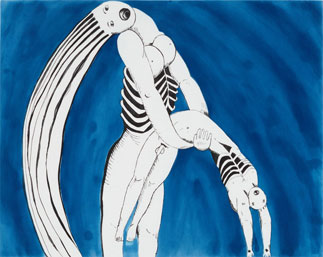
1995
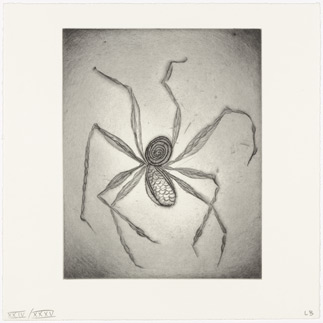
1996
Creates a series of fabric figures; four installed in St. Pancras Church, London.
Begins creating sculptures incorporating her old garments.
Peter Blum Edition publishes The View from the Bottom of the Well, a portfolio with nine drypoints and a text by the artist.
With printer Judith Solodkin of SOLO Impression, creates The Song of the Blacks and the Blues, a monumental lithograph and woodcut.
1996

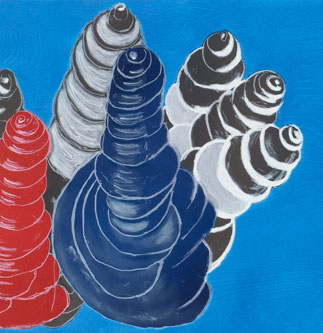
1998
In conjunction with the Whitney Museum of American Art, issues Topiary: The Art of Improving Nature, a portfolio of nine etchings with drypoint and aquatint; Museum also exhibits the portfolio.
1998
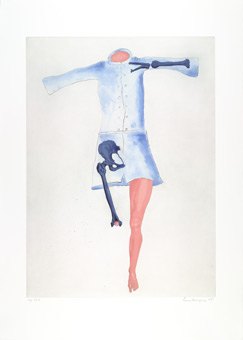
1999
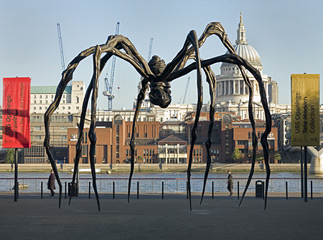
1989-1990
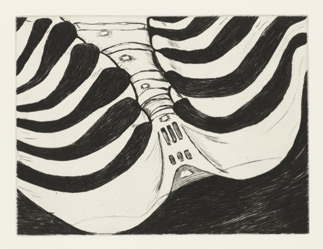
1991
Exhibits a series of six enclosed, room-size structures called Cells at the Carnegie International in Pittsburgh, introducing a major development in her work.
Exhibition Louise Bourgeois: L’Oeuvre gravé opens at Galerie Lelong, Zurich.
1992
At Documenta IX, exhibits Precious Liquids, a monumental Cell including a black male raincoat with small white fabric dress inside; clothing will begin to play major role as sculptural elements in her work.
At the Fabric Workshop, Philadelphia, stages, She Lost It, a performance piece, in conjunction with The Fabric Workshop’s 15th Anniversary Annual Benefit honoring Louise Bourgeois and Anne d’Harnoncourt; major prop is a gauze scroll with screenprinted text; performers wear white costumes embroidered with red texts.
Peter Blum Edition publishes the monumental print, Sainte Sébastienne.
Peter Blum Edition publishes Homely Girl, A Life, a two-volume illustrated book with drypoints in Volume I and photolithographs of medical images in Volume II. Text by Arthur Miller, written in 1991, involves a romance between a young woman and a blind man.
In conjunction with The Red Rooms, a major installation at Peter Blum Gallery, creates a large, three-part intaglio print, Triptych for the Red Room.
1993
Represents the United States at 45th Venice Biennale; an expanded exhibition, Louise Bourgeois: The Locus of Memory, organized by Charlotta Kotik, opens at The Brooklyn Museum in 1994 and tours internationally.
1989-93

1994
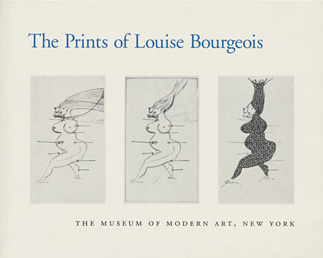
1994–95
During sleepless nights—she was plagued by insomnia—creates a series of 220 works on paper, kept as a group and called The Insomnia Drawings.
1995
Printer Felix Harlan, of Harlan & Weaver, re-furbishes her small printing press from the 1940s and sets it up in the lower level of her house; adds a second press there in 2003.
MoMA’s exhibition The Prints of Louise Bourgeois travels to the Bibliothèque nationale, Paris; Museum of Modern Art, Oxford (expanded with sculpture); Musée du Dessin et de l’Estampe Originale, Gravelines, France; and Bonnefanten Museum, Maastricht, The Netherlands.
The XIth Mostra da Gravura de Curitaba/Mostra América, in Curitaba, Brazil, includes a room dedicated to her prints.
Éditions du Solstice, a French bibliophile association, publishes Ode à Ma Mère, an illustrated book with nine drypoints and a text by the artist; its spider imagery reflects her concurrent preoccupation with this subject in sculpture.
1995-1996
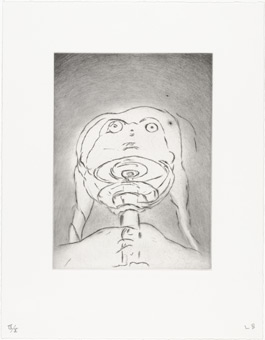
1997
Is awarded the National Medal of Arts by President Bill Clinton; among others recipients are jazz vocalist Betty Carter, arts patron Agnes Gund, and actor Jason Robards.
1997
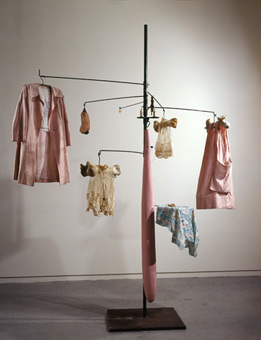
1999
Receives the Golden Lion at the Venice Biennale, awarded to a living master of contemporary art; also awarded the Praemium Imperiale in sculpture by the Japan Art Association.
The exhibition Louise Bourgeois Prints: 1989–1998 opens at the Maier Museum of Art of Randolph-Macon Woman’s College, Lynchburg, Va.; travels to Cleveland Center for Contemporary Art and The Minneapolis Institute of Arts.
Hires seamstress Mercedes Katz to help with fabric works; sets Katz up in a workshop-like area on a lower level of her home/studio.
1999
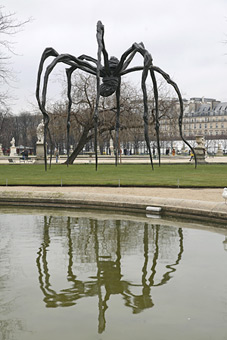
2000
2000
Creates I Do, I Undo, I Redo, an installation of three monumental towers, and Maman, a monumental Spider sculpture, for the inaugural exhibition in Tate Modern’s Turbine Hall.
With printers Harlan & Weaver, begins to make prints on her own handkerchiefs and linens.
After working with publisher Benjamin Shiff of Osiris earlier on, enters into a period of active collaboration with him that continues for the remainder of the decade; creates an extensive body of work, particularly in soft ground etching, on printing plates designed especially to fit her work table; proofing and printing by Wingate Studio. Osiris prints appear both as editions and as unique works, with hand additions and/or collage elements.
The exhibition Un duo en solo: Estampes 1942–1948 1974–2000, Carol Rama & Louise Bourgeois opens at the Cabinet cantonal des estampes, Vevey, Switzerland.
2001

2002
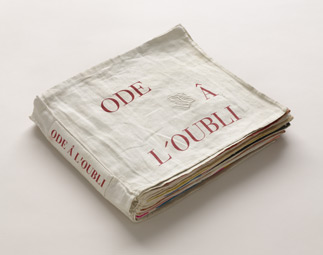
2003
With printer and publisher, Harlan & Weaver, creates La Réparation, a portfolio of seven intaglio prints; represents a compendium of her primary motifs.
The exhibition Louise Bourgeois: Repairs in the Sky, including a range of prints, opens at Museo Internacional de Arte Contemporáneo, Arrecife Lanzarote, Canary Islands.
2003
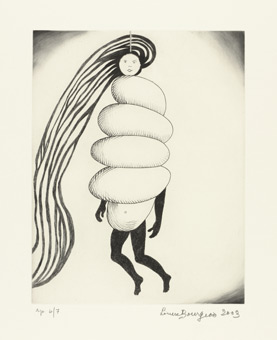
2005
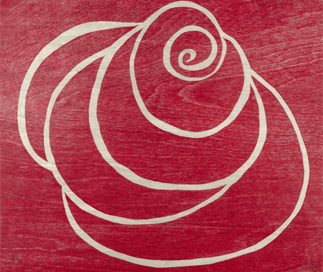
2006
In conjunction with a benefit series for the New Museum, works with publisher Carolina Nitsch Editions to issue The Young Girl, a drypoint on paper and cloth; follows up with Nitsch and Lison Editions (artist’s own imprint) to publish Hours of the Day, a bound book comprising twenty-five digital prints, as well as an unbound version of the same work.
2006
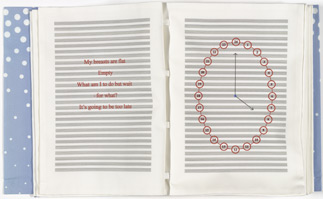
2008
French President Nicolas Sarkozy visits the artist at her house on 20th Street to present the Medal of the French Legion of Honor.
2008
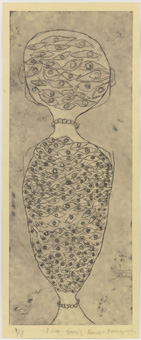
2009

2000
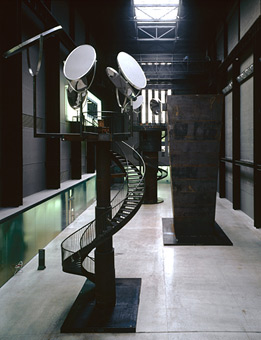
2001
Exhibits monumental Spider sculptures in Rockefeller Center, New York, in conjunction with the Public Art Fund.
Makes first unique fabric book, The Trauma of Abandonment, with photographic images taken by her father during WWI.
The exhibition Louise Bourgeois: Illustrated Books opens at the Miriam and Ira D. Wallach Art Gallery, Columbia University.
The exhibition Louise Bourgeois: Livres illustrés opens at The Musée d’art americain in Giverny, France.
2002
Creates first fabric collage book, Ode à l’Oubli, compiled from her old clothes and household items. In 2004, unbound and editioned version of the book appears, published by Peter Blum Edition and produced by Judith Solodkin of SOLO Impression, working with a crew and with assistance for digital printing from Raylene Marasco of Dyenamix. Will continue to work with Marasco for digital printing, and some screenprinting, for remainder of the decade.
With printer David Procuniar, of Procuniar Workshop, creates a series of 25 untitled screenprints of red abstract shapes on vintage fabric.
2002
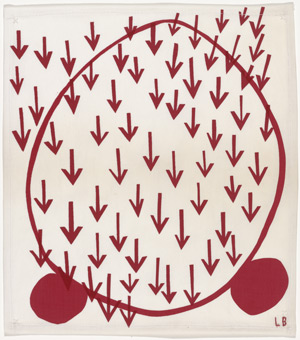
2004
The exhibition Louise Bourgeois: Estampes et livres illustrés opens at the Centre de la Gravure et de l’image imprimée, La Louvière, Belgium.
2005
With Watanabe Press, Brooklyn, creates Spirals, a series of twelve woodcuts, representing a rare use of the woodcut medium.
Creates a second edition of He Disappeared into Complete Silence, her celebrated 1947 illustrated book, as a benefit for The Museum of Modern Art; slightly alters the imagery, adds hand additions in color, and includes a new plate, Spider.
The exhibition Louise Bourgeois: Selected Prints 1989–2005 opens at Marlborough Graphics, London.
The exhibition Louise Bourgeois: Topiary, the Art of Improving Nature opens at the Memphis College of Art.
2005
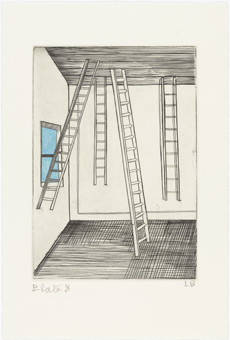
2007
The exhibition Louise Bourgeois: Retrospective, organized by Frances Morris, opens at Tate Modern; tours internationally.
Between 2007 and 2010, often incorporates printed elements on fabric in her unique works; for the printing, collaborates with Dyenamix, Harlan & Weaver, and Wingate Studio (for Osiris).
With publisher Carolina Nitsch Editions, creates The Fragile, a series of thirty-six hand-colored digital prints, meant to be installed together.
The exhibition Louise Bourgeois: La Sage Femme opens at Espacia AV, La Región de Murcia, Spain; focuses on prints and on Metamorfosis, an illustrated book created in collaboration with Maria Fluxà and published by Galerie Lelong in 1999.
The exhibition Louise Bourgeois: Recent Prints on Cloth and Paper opens at Marlborough Graphics, London.
The exhibition Louise Bourgeois: Recent Projects opens at the Haggerty Museum of Art, Marquette University, Milwaukee, and focuses on projects undertaken with Procuniar Workshop, New York.
2009
Collaborates with British artist Tracey Emin on Do Not Abandon Me, a series of sixteen gouache drawings, with texts by Emin, digitally printed on fabric by Dyenamix and published by Carolina Nitsch Editions.
The exhibition Louise Bourgeois: A Stretch of Time opens at Galerie Karsten Grevé, Cologne; features mixed media works with printed elements, created with Osiris.
The exhibition Louise Bourgeois: Prints opens at Galleri Andersson Sandström, Stockholm.
2010
2010
Collaborates with poet Gary Indiana, a friend since the 1980s, on To Whom It May Concern, a fabric illustrated book with his text.
The artist dies on May 31 at the age of 98.
The exhibition Fabric Works opens at the Fondazione Vedova, Venice; provides thorough survey of this body of work.
The exhibition Louise Bourgeois: Moi, Eugénie Grandet opens at the Maison de Balzac, Paris; includes a range of works, many with printed elements, on the subject of Honoré de Balzac’s heroine, Eugénie Grandet.
2011
The exhibition Louise Bourgeois: The Return of the Repressed opens at Fundación PROA, Buenos Aires; represents first investigation of the artist’s relationship to psychoanalysis.
The exhibition Louise Bourgeois: Suites on Fabric opens at Marlborough Graphics, London.
The exhibition He Disappeared into Complete Silence: Rereading a Single Artwork by Louise Bourgeois opens at De Hallen Haarlem, The Netherlands; a range of contemporary art is shown in the context of Bourgeois’s book.
2018
Louise Bourgeois: The Eternal Thread, a major retrospective, opens at the Long Museum, Shanghai, China.
2010
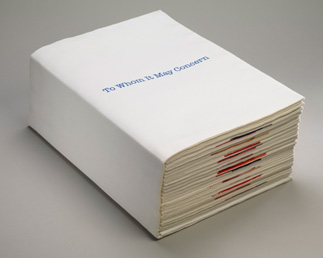
2015
Louise Bourgeois: Structures of Existence; The Cells, a comprehensive survey, opens at the Haus der Kunst in Munich.
2016
Louise Bourgeois Autobiographical Prints, a touring exhibition, is organized by Hayward Gallery, London.
2017
Louise Bourgeois: An Unfolding Portrait, a survey exhibition of prints and books—including works in other mediums—opens at The Museum of Modern Art, New York.
Born in Paris on December 25; the middle child, Bourgeois has an older sister, Henriette, and will have a younger brother, Pierre.
Family resides in Choisy-le-Roi, outside Paris, with their tapestry restoration workshop behind the house. In 1919 they move to Antony, setting up the workshop there. They also maintain a tapestry gallery in Paris.
Family employs an English tutor, Sadie Gordon Richmond, who lives with the family periodically until 1932.
Begins to assist in family tapestry workshop by drawing missing elements on the tapestries to be restored.
Mother dies after many years of illness; Bourgeois had tended to her and accompanied her on trips to more healthful climates.
Studies mathematics at the Sorbonne. Later turns to art, frequenting various Paris ateliers; also studies art history at the École du Louvre.
 St. Germain. 1938. Lithograph
St. Germain. 1938. Lithograph
Establishes an area within her father’s tapestry gallery to sell prints and paintings.
Meets Robert Goldwater, an American art historian, at the gallery. The couple marries and moves to New York; they raise three sons.
Makes first print, St. Germain, a holiday greeting card, in offset lithography; other printed holiday greeting cards follow in the 1940s. In late decades of her life, creates prints as holiday gifts for a small circle of friends.
Enrolls in the Art Students League in 1939, studying painting with Vaclav Vytlacil and lithography with Will Barnet; works on lithographs there into the early 1940s.
Early focus is on painting, drawing, and printmaking. Often works on prints at home, eventually purchasing a small intaglio press. Exhibits in various print exhibitions at such venues as the Brooklyn Museum, The Library of Congress, and the Pennsylvania Academy of the Fine Arts.
Family moves to East 18th Street, where they live until 1958; also purchases country home in Easton, Connecticut.
First solo painting exhibition at Bertha Schaefer Gallery, New York; also shows paintings in a solo exhibition at the Norlyst Gallery, New York, in 1947.
Begins to work at Atelier 17, the print workshop founded by Stanley William Hayter and relocated from Paris to New York during the war; will work there intermittently until 1949, enjoying the company of an array of international artists.
 He Disappeared into Complete Silence, Plate 7. 1947. Engraving and drypoint
He Disappeared into Complete Silence, Plate 7. 1947. Engraving and drypoint
Publishes He Disappeared into Complete Silence, an illustrated book comprised of nine engravings and accompanying parables written by the artist; most images are architectural or totemic in nature and resemble wood sculptures she will soon exhibit. Other prints of this time similarly reflect her growing preoccupation with sculpture.
 Bosom Lady. 1948. Engraving and drypoint
Bosom Lady. 1948. Engraving and drypoint
Shows totem-like wood sculptures in a solo exhibition at the Peridot Gallery; has a second solo show of sculpture there in 1950, and a solo show of drawings and sculpture in 1953.
 Sleeping Figure. 1950. Wood. Collection The Museum of Modern Art, New York
Sleeping Figure. 1950. Wood. Collection The Museum of Modern Art, New York
Father dies.
 Femme Volage. 1951. Wood and steel. Collection Solomon R. Guggenheim Museum, New York
Femme Volage. 1951. Wood and steel. Collection Solomon R. Guggenheim Museum, New York
Begins psychoanalysis; continues intensively until 1966, and then occasionally until 1984.
Becomes an American citizen.
Making use of the collection of illustrated books and prints she had accumulated over the years, opens a shop called Erasmus Books and Prints, on 11th Street, later moving it to Madison Avenue at 73rd Street. The shop closes in 1959.
Family moves to 347 West 20th Street; Bourgeois lives there for the rest of her life.
 Fée Couturière. 1963. Plaster. Collection The Easton Foundation
Fée Couturière. 1963. Plaster. Collection The Easton Foundation
Shows new, organically shaped plaster sculptures in a solo exhibition at the Stable Gallery, New York; work differs dramatically from the wood, totemic-like sculptures she exhibited in the late 1940s and early 1950s.
The exhibition Eccentric Abstraction, organized by Lucy R. Lippard, opens at Fischbach Gallery, New York; includes Bourgeois’s work, along with that of Eva Hesse, Bruce Nauman, and others who are seen to define a new, “anti-form” sensibility in art.
 Janus Fleuri. 1968. Bronze. Collection The Easton Foundation
Janus Fleuri. 1968. Bronze. Collection The Easton Foundation
 Cumul I. 1969. Marble. Collection Musée national d’art moderne, Centre Georges Pompidou, Paris
Cumul I. 1969. Marble. Collection Musée national d’art moderne, Centre Georges Pompidou, Paris
Husband dies.
Participates in a protest march in support of an employee strike at The Museum of Modern Art; carries a banner she has painted with the word “No” repeatedly; makes a related collage and will translate that imagery into various print mediums.
 No. 1973. Photostat
No. 1973. Photostat
Begins teaching sculpture and printmaking at School of Visual Arts, New York; continues through 1977.
Exhibits the room-sized installation piece The Destruction of the Father in Louise Bourgeois: Sculpture 1970–1974 at 112 Green Street Gallery, New York.
 Destruction of the Father. 1974. Plaster, latex, wood, and fabric. Collection The Easton Foundation
Destruction of the Father. 1974. Plaster, latex, wood, and fabric. Collection The Easton Foundation
Demonstrating that her work is receiving increasing attention, a major cover article appears in the March issue of Artforum magazine by Lucy R. Lippard entitled, “Louise Bourgeois: From the Inside Out.”
Receives an Honorary Doctor of Fine Arts degree from Yale University; President Gerald Ford is also a recipient.
 Confrontation. 1978. Wood, latex, and fabric. Collection Solomon R. Guggenheim Museum, New York. Photo © Peter Moore
Confrontation. 1978. Wood, latex, and fabric. Collection Solomon R. Guggenheim Museum, New York. Photo © Peter Moore
Stages elaborate performance with costumed participants called A Banquet/A Fashion Show of Body Parts at Hamilton Gallery, New York; takes place within a room-size sculpture entitled Confrontation.
In response to her disappointment at being excluded from an exhibition at the Whitney Museum of American Art, creates series of rubbings called Whitney Murders.
Meets Jerry Gorovoy through his work at the Max Hutchinson Gallery, New York; he organizes an exhibition of her work there and later becomes her primary assistant.
 Whitney Murders. 1978. Rubbing and stencil
Whitney Murders. 1978. Rubbing and stencil
Purchases large loft in Brooklyn for use as a studio, enabling her to create large-scale sculpture; also continues to work at home on West 20th Street.
First retrospective exhibition, Louise Bourgeois, organized by Deborah Wye, opens at The Museum of Modern Art; accompanying catalogue is first monographic study of the artist.
Is named Officier de L’Ordre des Arts et des Lettres, by Jack Lang, French Minister of Culture.
 Louise Bourgeois. The Museum of Modern Art. 1983
Louise Bourgeois. The Museum of Modern Art. 1983
 Femme Maison. 1984. Photogravure
Femme Maison. 1984. Photogravure
Creates small edition of Femme Maison prints based on a 1947 drawing and related painting; drawing became known as a symbol of the women’s movement in art and served as the cover image of Lucy R. Lippard’s 1976 book, From the Center: Feminist Essays on Women’s Art.
 The She-Fox. 1985. Marble and steel. Collection Museum of Contemporary Art, Chicago
The She-Fox. 1985. Marble and steel. Collection Museum of Contemporary Art, Chicago
Creates Articulated Lair, a room-size sculpture considered a precursor to her works known as Cells, which proliferate in the 1990s and 2000s.
Meets publisher Benjamin Shiff of Osiris, and Peter Blum of Peter Blum Edition; relationships will lead to extensive range of print projects.
First European retrospective, organized by Peter Weiermair, opens at Frankfurter Kunstverein, West Germany.
Begins working with lithography printer Judith Solodkin of SOLO Impression, intaglio printers Harlan & Weaver, and intaglio printer Christian Guérin of Gravure; will create a variety of projects with Solodkin, and an extensive body of work with Harlan & Weaver, as Felix Harlan eventually establishes a regular routine with the artist involving both his workshop and the small presses set up in her basement.
 Anatomy, No. 5. 1989-1990. Drypoint
Anatomy, No. 5. 1989-1990. Drypoint
Peter Blum Edition publishes Anatomy, a portfolio of 11 intaglio prints and 1 multiple; imagery reflects her long-standing preoccupation with body parts as subjects.
Osiris (Benjamin Shiff, Director) publishes the puritan, an illustrated book with eight engravings and a text written by the artist in 1947.
 the puritan, Plate 7. 1990. Engraving, with gouache additions
the puritan, Plate 7. 1990. Engraving, with gouache additions
Exhibits a series of six enclosed, room-size structures called Cells at the Carnegie International in Pittsburgh, introducing a major development in her work.
Exhibition Louise Bourgeois: L’Oeuvre gravé opens at Galerie Lelong, Zurich.
 Sainte Sébastienne. 1992. Drypoint
Sainte Sébastienne. 1992. Drypoint
 Homely Girl, A Life, Volume II, Untitled. 1992. Photolithograph
Homely Girl, A Life, Volume II, Untitled. 1992. Photolithograph
At Documenta IX, exhibits Precious Liquids, a monumental Cell including a black male raincoat with small white fabric dress inside; clothing will begin to play major role as sculptural elements in her work.
At the Fabric Workshop, Philadelphia, stages, She Lost It, a performance piece, in conjunction with The Fabric Workshop’s 15th Anniversary Annual Benefit honoring Louise Bourgeois and Anne d’Harnoncourt; major prop is a gauze scroll with screenprinted text; performers wear white costumes embroidered with red texts.
Peter Blum Edition publishes the monumental print, Sainte Sébastienne.
Peter Blum Edition publishes Homely Girl, A Life, a two-volume illustrated book with drypoints in Volume I and photolithographs of medical images in Volume II. Text by Arthur Miller, written in 1991, involves a romance between a young woman and a blind man.
In conjunction with The Red Rooms, a major installation at Peter Blum Gallery, creates a large, three-part intaglio print, Triptych for the Red Room.
 Arch of Hysteria. 1993. Bronze. Collection The Easton Foundation
Arch of Hysteria. 1993. Bronze. Collection The Easton Foundation
Represents the United States at 45th Venice Biennale; an expanded exhibition, Louise Bourgeois: The Locus of Memory, organized by Charlotta Kotik, opens at The Brooklyn Museum in 1994 and tours internationally.
 Cell (Eyes and Mirrors). 1989-93. Marble, mirrors, steel, and glass. Collection Tate Modern, London
Cell (Eyes and Mirrors). 1989-93. Marble, mirrors, steel, and glass. Collection Tate Modern, London
First print retrospective, The Prints of Louise Bourgeois, organized by Deborah Wye, opens at The Museum of Modern Art on the occasion of the publication of a print catalogue raisonné of the same title by Wye and Carol Smith.
 The Prints of Louise Bourgeois by Deborah Wye and Carol Smith. 1994
The Prints of Louise Bourgeois by Deborah Wye and Carol Smith. 1994

 Triptych for the Red Room, with detail. 1994. Aquatint, drypoint, and engraving
Triptych for the Red Room, with detail. 1994. Aquatint, drypoint, and engraving
During sleepless nights—she was plagued by insomnia—creates a series of 220 works on paper, kept as a group and called The Insomnia Drawings.
 Ode à Ma Mère. Plate 8. 1995. Drypoint and roulette
Ode à Ma Mère. Plate 8. 1995. Drypoint and roulette
Printer Felix Harlan, of Harlan & Weaver, re-furbishes her small printing press from the 1940s and sets it up in the lower level of her house; adds a second press there in 2003.
MoMA’s exhibition The Prints of Louise Bourgeois travels to the Bibliothèque nationale, Paris; Museum of Modern Art, Oxford (expanded with sculpture); Musée du Dessin et de l’Estampe Originale, Gravelines, France; and Bonnefanten Museum, Maastricht, The Netherlands.
The XIth Mostra da Gravura de Curitaba/Mostra América, in Curitaba, Brazil, includes a room dedicated to her prints.
Éditions du Solstice, a French bibliophile association, publishes Ode à Ma Mère, an illustrated book with nine drypoints and a text by the artist; its spider imagery reflects her concurrent preoccupation with this subject in sculpture.
Creates a series of fabric figures; four installed in St. Pancras Church, London.
Begins creating sculptures incorporating her old garments.
Peter Blum Edition publishes The View from the Bottom of the Well, a portfolio with nine drypoints and a text by the artist.
With printer Judith Solodkin of SOLO Impression, creates The Song of the Blacks and the Blues, a monumental lithograph and woodcut.

 The Song of the Blacks and the Blues, with detail. 1996. Lithograph and woodcut with gouache and oilstick additions
The Song of the Blacks and the Blues, with detail. 1996. Lithograph and woodcut with gouache and oilstick additions
 The View from the Bottom of the Well, Untitled. 1995-1996. Drypoint
The View from the Bottom of the Well, Untitled. 1995-1996. Drypoint
Is awarded the National Medal of Arts by President Bill Clinton; among others recipients are jazz vocalist Betty Carter, arts patron Agnes Gund, and actor Jason Robards.
 Pink Days and Blue Days. 1997. Steel, fabric, bone, mixed media. Collection Whitney Museum of American Art, New York
Pink Days and Blue Days. 1997. Steel, fabric, bone, mixed media. Collection Whitney Museum of American Art, New York
In conjunction with the Whitney Museum of American Art, issues Topiary: The Art of Improving Nature, a portfolio of nine etchings with drypoint and aquatint; Museum also exhibits the portfolio.
 Topiary: The Art of Improving Nature, Untitled. 1998. Aquatint, drypoint, and etching
Topiary: The Art of Improving Nature, Untitled. 1998. Aquatint, drypoint, and etching
Receives the Golden Lion at the Venice Biennale, awarded to a living master of contemporary art; also awarded the Praemium Imperiale in sculpture by the Japan Art Association.
The exhibition Louise Bourgeois Prints: 1989–1998 opens at the Maier Museum of Art of Randolph-Macon Woman’s College, Lynchburg, Va.; travels to Cleveland Center for Contemporary Art and The Minneapolis Institute of Arts.
Hires seamstress Mercedes Katz to help with fabric works; sets Katz up in a workshop-like area on a lower level of her home/studio.
 Maman. 1999. Bronze, stainless steel, and marble. (In the Tuileries Garden, 2008)
Maman. 1999. Bronze, stainless steel, and marble. (In the Tuileries Garden, 2008)
 Maman. 1999. Bronze, stainless steel, and marble. (At Tate Modern, 2007)
Maman. 1999. Bronze, stainless steel, and marble. (At Tate Modern, 2007)
Creates I Do, I Undo, I Redo, an installation of three monumental towers, and Maman, a monumental Spider sculpture, for the inaugural exhibition in Tate Modern’s Turbine Hall.
With printers Harlan & Weaver, begins to make prints on her own handkerchiefs and linens.
After working with publisher Benjamin Shiff of Osiris earlier on, enters into a period of active collaboration with him that continues for the remainder of the decade; creates an extensive body of work, particularly in soft ground etching, on printing plates designed especially to fit her work table; proofing and printing by Wingate Studio. Osiris prints appear both as editions and as unique works, with hand additions and/or collage elements.
The exhibition Un duo en solo: Estampes 1942–1948 1974–2000, Carol Rama & Louise Bourgeois opens at the Cabinet cantonal des estampes, Vevey, Switzerland.
 I Do, I Undo, I Redo from Louise Bourgeois. Tate Modern, Turbine Hall, 2000
I Do, I Undo, I Redo from Louise Bourgeois. Tate Modern, Turbine Hall, 2000
 Rejection. 2001. Fabric, steel, and lead
Rejection. 2001. Fabric, steel, and lead
Exhibits monumental Spider sculptures in Rockefeller Center, New York, in conjunction with the Public Art Fund.
Makes first unique fabric book, The Trauma of Abandonment, with photographic images taken by her father during WWI.
The exhibition Louise Bourgeois: Illustrated Books opens at the Miriam and Ira D. Wallach Art Gallery, Columbia University.
The exhibition Louise Bourgeois: Livres illustrés opens at The Musée d’art americain in Giverny, France.
 Ode à l’Oubli. 2002. Fabric illustrated book
Ode à l’Oubli. 2002. Fabric illustrated book
Creates first fabric collage book, Ode à l’Oubli, compiled from her old clothes and household items. In 2004, unbound and editioned version of the book appears, published by Peter Blum Edition and produced by Judith Solodkin of SOLO Impression, working with a crew and with assistance for digital printing from Raylene Marasco of Dyenamix. Will continue to work with Marasco for digital printing, and some screenprinting, for remainder of the decade.
With printer David Procuniar, of Procuniar Workshop, creates a series of 25 untitled screenprints of red abstract shapes on vintage fabric.
 Untitled. 2002. Screenprint on fabric
Untitled. 2002. Screenprint on fabric
With printer and publisher, Harlan & Weaver, creates La Réparation, a portfolio of seven intaglio prints; represents a compendium of her primary motifs.
The exhibition Louise Bourgeois: Repairs in the Sky, including a range of prints, opens at Museo Internacional de Arte Contemporáneo, Arrecife Lanzarote, Canary Islands.
 Spiral Woman from La Réparation. 2003. Drypoint and engraving
Spiral Woman from La Réparation. 2003. Drypoint and engraving
The exhibition Louise Bourgeois: Estampes et livres illustrés opens at the Centre de la Gravure et de l’image imprimée, La Louvière, Belgium.
 Untitled from Spirals. 2005. Woodcut
Untitled from Spirals. 2005. Woodcut
With Watanabe Press, Brooklyn, creates Spirals, a series of twelve woodcuts, representing a rare use of the woodcut medium.
Creates a second edition of He Disappeared into Complete Silence, her celebrated 1947 illustrated book, as a benefit for The Museum of Modern Art; slightly alters the imagery, adds hand additions in color, and includes a new plate, Spider.
The exhibition Louise Bourgeois: Selected Prints 1989–2005 opens at Marlborough Graphics, London.
The exhibition Louise Bourgeois: Topiary, the Art of Improving Nature opens at the Memphis College of Art.
 He Disappeared into Complete Silence, second edition, Plate 8. 2005. Engraving over photogravure, with watercolor additions
He Disappeared into Complete Silence, second edition, Plate 8. 2005. Engraving over photogravure, with watercolor additions
In conjunction with a benefit series for the New Museum, works with publisher Carolina Nitsch Editions to issue The Young Girl, a drypoint on paper and cloth; follows up with Nitsch and Lison Editions (artist’s own imprint) to publish Hours of the Day, a bound book comprising twenty-five digital prints, as well as an unbound version of the same work.
 Hours of the Day. 2006. Digital prints on fabric
Hours of the Day. 2006. Digital prints on fabric
The exhibition Louise Bourgeois: Retrospective, organized by Frances Morris, opens at Tate Modern; tours internationally.
Between 2007 and 2010, often incorporates printed elements on fabric in her unique works; for the printing, collaborates with Dyenamix, Harlan & Weaver, and Wingate Studio (for Osiris).
With publisher Carolina Nitsch Editions, creates The Fragile, a series of thirty-six hand-colored digital prints, meant to be installed together.
The exhibition Louise Bourgeois: La Sage Femme opens at Espacia AV, La Región de Murcia, Spain; focuses on prints and on Metamorfosis, an illustrated book created in collaboration with Maria Fluxà and published by Galerie Lelong in 1999.
The exhibition Louise Bourgeois: Recent Prints on Cloth and Paper opens at Marlborough Graphics, London.
The exhibition Louise Bourgeois: Recent Projects opens at the Haggerty Museum of Art, Marquette University, Milwaukee, and focuses on projects undertaken with Procuniar Workshop, New York.
French President Nicolas Sarkozy visits the artist at her house on 20th Street to present the Medal of the French Legion of Honor.
 I See You!!. 2008. Etching
I See You!!. 2008. Etching
 Do Not Abandon Me. 2009. Collaboration with Tracey Emin. Digital print, with ink additions, on fabric
Do Not Abandon Me. 2009. Collaboration with Tracey Emin. Digital print, with ink additions, on fabric
Collaborates with British artist Tracey Emin on Do Not Abandon Me, a series of sixteen gouache drawings, with texts by Emin, digitally printed on fabric by Dyenamix and published by Carolina Nitsch Editions.
The exhibition Louise Bourgeois: A Stretch of Time opens at Galerie Karsten Grevé, Cologne; features mixed media works with printed elements, created with Osiris.
The exhibition Louise Bourgeois: Prints opens at Galleri Andersson Sandström, Stockholm.
Collaborates with poet Gary Indiana, a friend since the 1980s, on To Whom It May Concern, a fabric illustrated book with his text.
The artist dies on May 31 at the age of 98.
The exhibition Fabric Works opens at the Fondazione Vedova, Venice; provides thorough survey of this body of work.
The exhibition Louise Bourgeois: Moi, Eugénie Grandet opens at the Maison de Balzac, Paris; includes a range of works, many with printed elements, on the subject of Honoré de Balzac’s heroine, Eugénie Grandet.
 To Whom it May Concern. 2010. Collaboration with Gary Indiana. Fabric illustrated book with 12 digital prints
To Whom it May Concern. 2010. Collaboration with Gary Indiana. Fabric illustrated book with 12 digital prints
The exhibition Louise Bourgeois: The Return of the Repressed opens at Fundación PROA, Buenos Aires; represents first investigation of the artist’s relationship to psychoanalysis.
The exhibition Louise Bourgeois: Suites on Fabric opens at Marlborough Graphics, London.
The exhibition He Disappeared into Complete Silence: Rereading a Single Artwork by Louise Bourgeois opens at De Hallen Haarlem, The Netherlands; a range of contemporary art is shown in the context of Bourgeois’s book.
Louise Bourgeois: Structures of Existence; The Cells, a comprehensive survey, opens at the Haus der Kunst in Munich.
Louise Bourgeois Autobiographical Prints, a touring exhibition, is organized by Hayward Gallery, London.
Louise Bourgeois: An Unfolding Portrait, a survey exhibition of prints and books—including works in other mediums—opens at The Museum of Modern Art, New York.
Louise Bourgeois: The Eternal Thread, a major retrospective, opens at the Long Museum, Shanghai, China.
“Art is not about art.
Art is about life,
and that sums it up.”